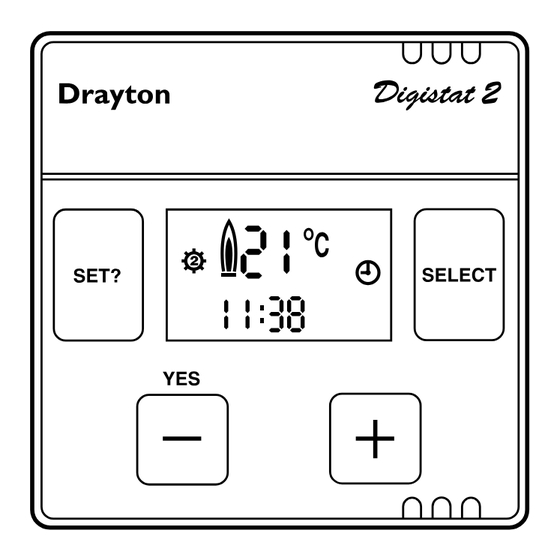
Advertisement
Quick Links
Digistat 2 user instructions
INITIAL START UP
Open the battery compartment situated at the bottom left
hand corner (press to unlatch and slide down). Remove the
insulator strip from between the batteries and their contacts
and close the compartment.
The unit will now display the actual
room temperature and time at 12.00 am,
midnight (Diagram A).
If the unit has been stored in a cold
place, it may take time to warm up.
Digistat 2 has an indicator to show
when the heating system is ON or OFF,
e.g. if the SET temperature is 20°C and
the actual room temperature is below
20°C a flame symbol will appear on the
display (Diagram B). This indicates a de-
mand for heat (system will switch ON).
During normal operation, the Digistat 2 will display actual
room temperature continuously.
SETTING THE TIME OF DAY
The diagram next to each step description shows resulting display.
1. Press "SET?" button
2. Press "Yes" (–) button. The hours
will flash as shown here. Use the +
and – buttons to set correct hour.
3. Press "SET?" button again and the
minutes will flash, use + and –
buttons to set correct minute time.
4. Press "SET?" button twice to return
to normal operating mode.
PRE-PROGRAMMED TIMES AND
TEMPERATURES
The Digistat 2 comes with the following preset programme.
Symbol
Diagram A
SYSTEM OFF
SYSTEM ON
Diagram B
* 16°C if selector pin removed, see installation instructions
TO VIEW OR CHANGE THE FACTORY
(steps 1-4)
SETTINGS
5. Press the "SET?" button until this
display is shown.
6. Press the Yes (–) button again. This
tells you that at 6.30 a.m., the heating
system will control your home at
20°C. If you wish to alter the
temperature use the + and – buttons.
7. Press the "SET?" button. The time
will now flash. If you wish to alter the
switching time use the + and
– buttons. This will change the
switching time in 10 minute steps.
Setting
Time
Temperature
1st day time
6.30 am
20°C
2nd day time
8.30 am
16°C
3rd day time
4.30 pm
21°C
Night time
10.30 pm
7°C*
(steps 5-10)
8. Press the "SET?" button, this tells you
that at 8.30 a.m., the heating system
will control your home at 16°C. If you
wish to alter this temperature use the
+ and – buttons.
9. Continue to press the "SET?" button
as in steps 6 and 7 above to advance
through the times and temperatures.
If you wish to alter any of the times
and temperatures use the + and
– button, when the one you wish to alter is flashing.
10.Continue to press "SET?" button until
you return to normal operating mode
with a display similar to the one shown
here.
OPERATING MODES
The Digistat can be operated in one of three modes.
1)
– Timed, all preset times and temperatures
2)
– Continuous night temperature (useful for low limit
temperature protection when on holiday)
3)
– Continuous 'DAY 1' temperature
1
Use the SELECT button to change the operating mode to suit
your requirements, the symbols are positioned on the right
hand side of the display.
TEMPERATURE OVERRIDE
If at anytime during normal operation you wish to temporarily
increase or decrease the set temperature, use the + or –
buttons to change to your desired setting. This can be done
without entering the SET mode. Five seconds after releasing the
+ or – button the display will revert to showing the actual
room temperature. The Digistat will now control the
temperature to the override setting until the next programmed
switching time, when it will revert to the times and
temperatures you have already programmed.
Continued overleaf.
Advertisement

Summary of Contents for Drayton Digistat 2
- Page 1 If you wish to alter any of the times If the unit has been stored in a cold The Digistat 2 comes with the following preset programme. and temperatures use the + and place, it may take time to warm up.
-
Page 2: Battery Replacement
12.00 am (midnight) so Siebe Climate Controls Limited Chantry Close, West Drayton, Middlesex UB7 7SP long as it is not programmed more than 23 hours 50 minutes Telephone: (01895) 444012 Sales Fax: (01895) 421901 after the Day 1 setting.














Need help?
Do you have a question about the Digistat 2 and is the answer not in the manual?
Questions and answers
Flame is showing but heating not o as rads cold
The heating is not working on the Drayton Digistat 2 despite the flame symbol showing because the receiver may be faulty. If the receiver is switching on but not activating the boiler, it suggests a malfunction in the receiver. A possible solution is to check the wiring of the receiver or perform a full reset following the manufacturer's instructions. If the issue persists, the receiver may need to be replaced.
This answer is automatically generated